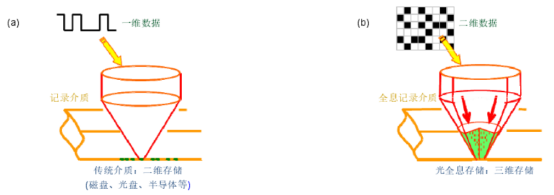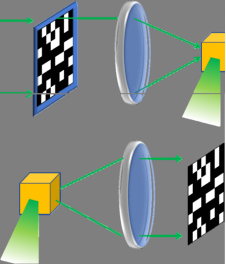Holographic storage and its material development history - Dr. Li Qian
2021-08-02
After the CPU era, in which computing speed was the main task, and the network era, in which information transmission, transmission and exchange were the main contradictions, information technology has now entered the information storage era, in which information storage and safe backup were the main contradictions. Since the beginning of the 21st century, the recording density of magnetic and magneto-optical recording storage has been greatly improved by developing new materials, improving the storage performance of materials, using high-performance soft magnetic materials as magnetic heads, reducing the size of recording spot, using multilayer coupling and super resolution readout. Disks can be up to 10 Gb/ IN2 and magneto-optical disks can be up to 20 Gb/in2. However, magnetic and magneto-optical recording bits cannot be infinitely small, and a recording density of the order of 100 Gb/in2 may be the limit for magnetic and magneto-optical recording. In the optical disk storage, people through the research and development of new organic photochemical materials, the use of short wavelength laser reading and writing, improving the trace density and line density, the development of most layer disks, improve the disk surface speed and other technologies, significantly improve the optical disk storage density and transmission rate. On this basis, the concept of holographic storage is proposed.
Holographic storage is a kind of ultra-high density storage technology, which uses the interference of light to record information in the form of holography on the recording material, and then recovers the stored information in the form of diffraction under certain conditions. Holography is all information of object, including intensity distribution and phase distribution of object light wave.
Features of holographic storage:
1, high storage density, large capacity. The upper limit of holographic storage capacity is L λ3. Theoretically, holographic storage density can reach 1 Tb/cm3(1 Tb=1000 Gb), and the current technology has reached 10 Gb/cm3. High storage density is obtained by recording multiple holograms in the same area of the photosensitive material. At present, the most commonly used multiple recording methods include multi-wavelength, multi-angle and multi-phase recording. In order to obtain higher storage density, several multiple recording methods can be combined. For example, a combination of wavelength and Angle can be used for recording.
2. High data transmission rate and short access time. Holograms are stored and read on a whole page, with all the bits of information on a page being recorded and read in parallel. In addition, holographic databases can be addressed by means of inertial-less beam deflection (such as acoustooptic deflectors) or wavelength selection without the electromechanical read/write heads required in disk and OPTICAL disk storage, and thus data transmission and access rates can be high.
3. High redundancy. Unlike bit-by-bit disks and optical disks, holograms store information in a distributed manner, with each bit of information stored on the entire surface or volume of the hologram, so local defects and damage in the recording medium do not cause loss of information.
4. High storage reliability. All holographic storage materials are silver salt crystal, organic polymer or metal compound crystal with good optical performance and stable chemical performance. Like the negative of a hologram, even if the storage carrier is partially damaged, the full data can still be read, but with reduced clarity. The information recorded by holographic storage materials can be kept for more than 30 years.
5. Parallel content addressing. Holographic memory can directly output the optical reconstruction information of data pages or images, so it can be used for parallel page oriented retrieval and recognition, and has fast content related addressing function. This unique performance can be used to build content-addressed memory. Figure 1 shows a comparison between conventional storage (a) and optical holographic storage (b).

FIG. 1 Comparison of conventional storage (a) and optical holographic storage (b).
As early as 1948, Gabor proposed the concept of holography, which only involved the method of wavefront reconstruction, and did not connect holography with data storage, but used holography for the amplification of X-ray images. The main initial problem was that there was no good coherent light source, so the coaxial wavefront reconstruction system would have conjugated images. Although Gabor and other scientists such as Kirkpatrick and ElSum, Baez and Rogers were involved in solving this problem, the results were never very good. With the advent of lasers in the early 1960s, a good coherent light source was found, and holography began to enter a stage of rapid development. At this time, clear image recording and reconstruction could be achieved. Moreover, due to the good coherence of the light source, Leith et al. proposed a holographic recording system with reference light off-axis. In this way, aliasing of the reconstructed conjugate images in Gabor hologram is avoided. In 1963, Van Heerden formally proposed the concept of holographic data storage. He attributes holographic data storage to three-dimensional solid-state optical information storage and estimates its storage density limit as V/λ3(V being the volume of the recording material and λ being the wavelength of the recording light). Van Heerden then discusses the possibility of using reference light angles to reuse and wavelength to reuse in holographic data storage. In the early development of holographic data storage, Leith et al. proposed and verified the technique of recording disc rotation multiplexing. At this time, the holographic technology has been quite embryonic, but the lack of effective recording materials, holographic data storage is mostly on the method of discussion. In 1966, Ashkin et al. of Bell LABS discovered the photorefractive effect unexpectedly when they carried out frequency doubling experiments with lithium niobate crystals. As a photorefractive crystal, lithium niobate crystal has been widely studied and used in holographic data storage, which makes 3d volume holographic data storage become a research hotspot again. Due to the development of materials, a series of verification experiments on holographic data storage have been published, and more reuse techniques have been studied. Figure 2 shows the schematic diagram of holographic storage technology.

Figure 2. Schematic diagram of holographic storage technology
Until the early 90 s, along with the recording materials, spatial light modulator, the development of CCD detector and other key materials and devices, the storage density of the holographic data storage system can be greatly increased, the optical holographic data storage has entered a rapid development period, in the whole system, materials research and reuse theory has improved comprehensively.
In 1994, a joint organization of seven companies and university Research groups, including IBM and Stanford University, was partially sponsored by the Defense Advanced Research Projects Agency (DARPA), It mainly studies the optical Refraction information storage Material (PRISM), which is used in holographic storage. It is expected to develop a holographic data storage system with 1013 bit storage capacity and 1 Gb/s data conversion rate within five years. The material's test system, provided by IBM, not only stores and reconstructs the holograms of the big data pages, but also performs bit error rate analysis on the reconstructed results. The world's first complete holographic data storage system was jointly built by Stanford University, Siros, IBM and companies such as Rockwell and Thousand Oaks. Researchers at Caltech and Lucent have also demonstrated similar systems.
In 1994, DuPont company in the United States developed a Photopolymer based on free radical polymerization. Curtis et al. conducted an in-depth study on the holographic storage properties of this photo-polymer material product, and carried out holographic storage experiments using the cyclic multiplexing and Angle multiplexing techniques. Subsequently, Pu et al. made a holographic disc from this material and reused 32 holograms in each planar unit region to obtain a storage surface density of 109 bit/cm2. The sensitivity of photosensitive polymers is two orders of magnitude higher than that of photorefractive crystals, but the problem of material shrinkage is also serious, so it is necessary to find a balance between the dynamic response range and the shrinkage of the material. Bieringer explains this in more detail. Polaroid and Bell LABS researchers took different approaches to the material research problem. Polaroid used cationic open-loop materials for experimental verification, while Bell LABS and Lucent based on free radiation media for experimental verification.
There is also some basis for the research of light holographic storage in China. Especially in the decade of the rapid development of light holographic storage in the 1990s, domestic scholars have followed the pace and made great achievements. Tao Shiquan et al recorded the material from lithium niobate crystal
We have done a lot of work on disc holographic storage of photorefractive crystals, and put forward a feasible scheme which can record and reconstruct the information better. Guo Yajun et al. compared the recording properties of lithium niobate crystals with different doping ratios and optimized the photorefractive crystal recording materials. Liu Youwen and Zhou Changhe et al studied double and triple doped lithium niobate crystals. Gan's team has done a lot of research on photopolymeric materials, which are easier to prepare, cheaper and more photosensitive than photorefractive crystals. Jin Guofan et al. have done a lot of research on the system problems of holographic storage, such as the Spatial Light Modulator, SLM) and CCD pixel registration problems, system miniaturization, SLM and CCD device performance within the page on the noise problem, the influence of the reference beam of off-axis holographic storage system to join displacement speckle and realize dynamic speckle multiplexing, can inhibit the crosstalk noise created multiple longitudinal mode laser, etc., mainly focusing on the research of off-axis holographic system.
After 2012, the era of big data came, and the market of data storage increased dramatically. The preparation of organic photopolymer materials has made great progress in recent years. Tan's team proposed phase-shaped holographic data
Storage method, and a lot of related research. Phase holographic data storage is becoming a research hotspot because of its higher storage capacity and higher SNR.
With the development of optical holographic data storage technology for more than 50 years, the theory has been relatively complete. With the continuous development of key devices and materials, the practice has become increasingly mature. Now in the era of big data with explosive growth of data, the demand for massive data storage and the demand for 5G high-speed data communication have brought new development opportunities for optical holographic data storage technology. It can be said that this technology has already received enough nutrients and will soon break ground. In the near future, coaxial optical holographic data storage technology will usher in a larger stage, and the combination of phase holographic storage theory and coaxial system will also produce a broader space for development.
